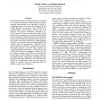Free Online Productivity Tools
i2Speak
i2Symbol
i2OCR
iTex2Img
iWeb2Print
iWeb2Shot
i2Type
iPdf2Split
iPdf2Merge
i2Bopomofo
i2Arabic
i2Style
i2Image
i2PDF
iLatex2Rtf
Sci2ools
ISMB
1996
1996
Compact Encoding Strategies for DNA Sequence Similarity Search
Determining whether two DNA sequences are similar is an essential component of DNA sequence analysis. Dynamic programming is the algorithm of choice if computational time is not the most important consideration. Heuristic search tools, such as BLAST, are computationally more efficient, but they may miss some of the sequence similarities (Altschul et al., 1990). These tools often use common k-tuples (words) between the two sequences to determine anchor points for the alignment, and spend most of their computational time extending the alignment beyond these anchor points. We discuss and provide a DNA sequence similarity search implementation (called SENSEI) that improves upon the performance of BLASTN by almost an order of magnitude for comparable sensitivity. This improvement is a result of using compactly encoded scoring tables for k-tuples, encoding bases with a single bit, filtering the sequence to remove the simple sequence repeats using XNUN, and masking the known species-specific...
Related Content
| Added | 02 Nov 2010 |
| Updated | 02 Nov 2010 |
| Type | Conference |
| Year | 1996 |
| Where | ISMB |
| Authors | David J. States, Pankaj Agarwal |
Comments (0)

